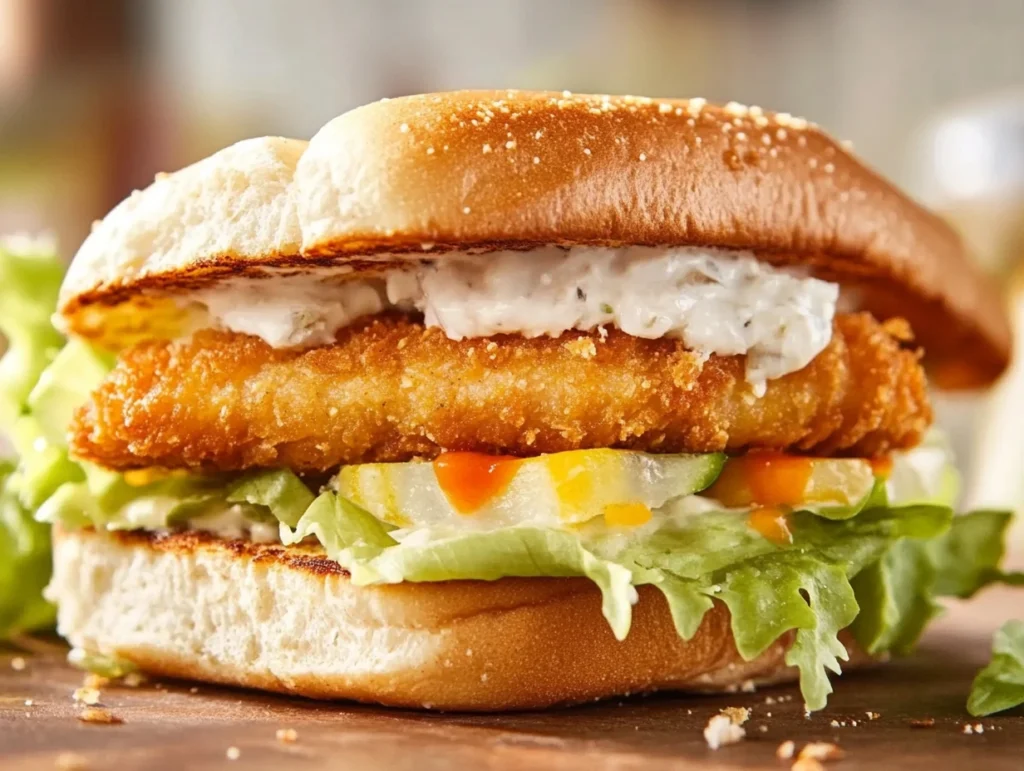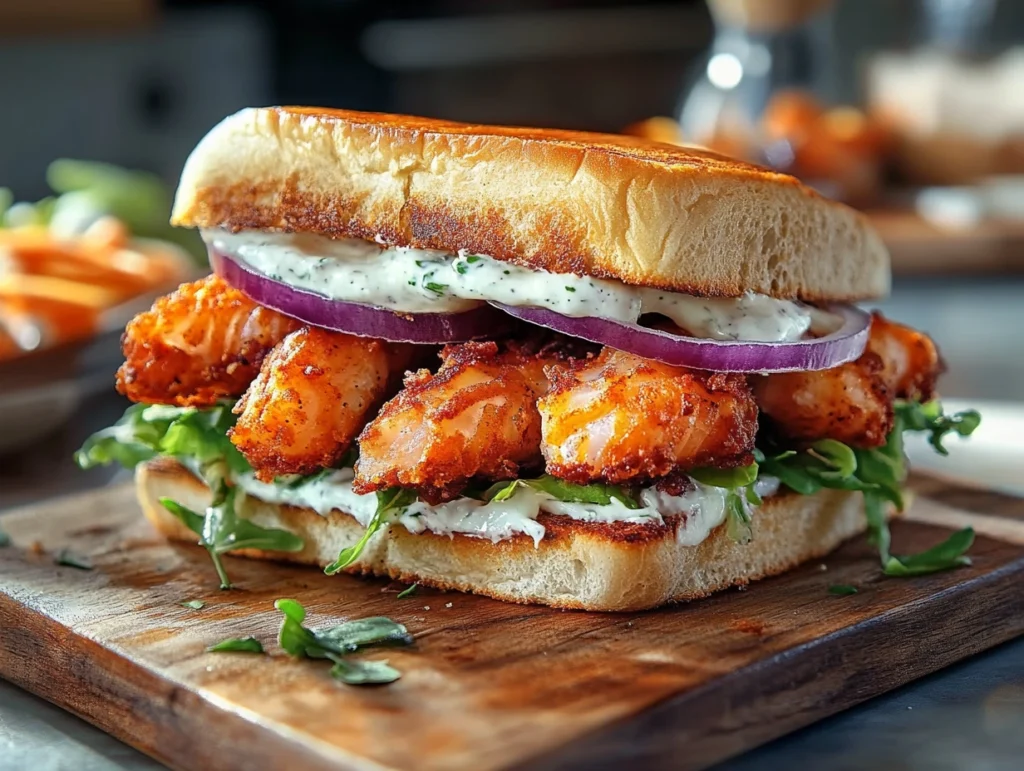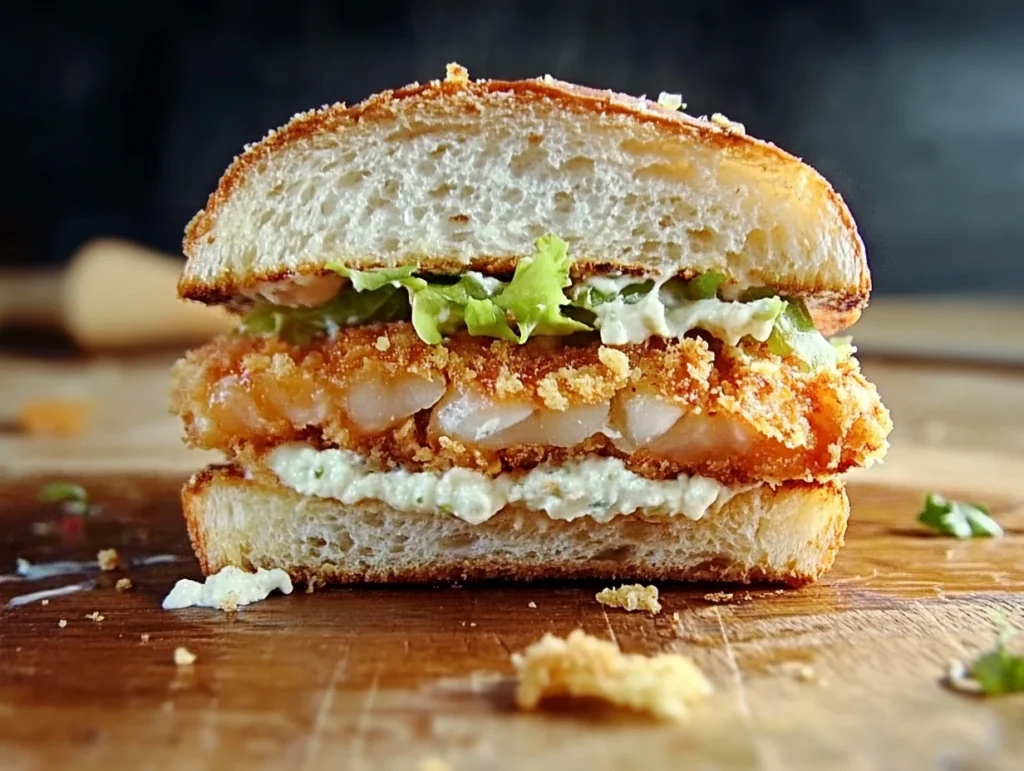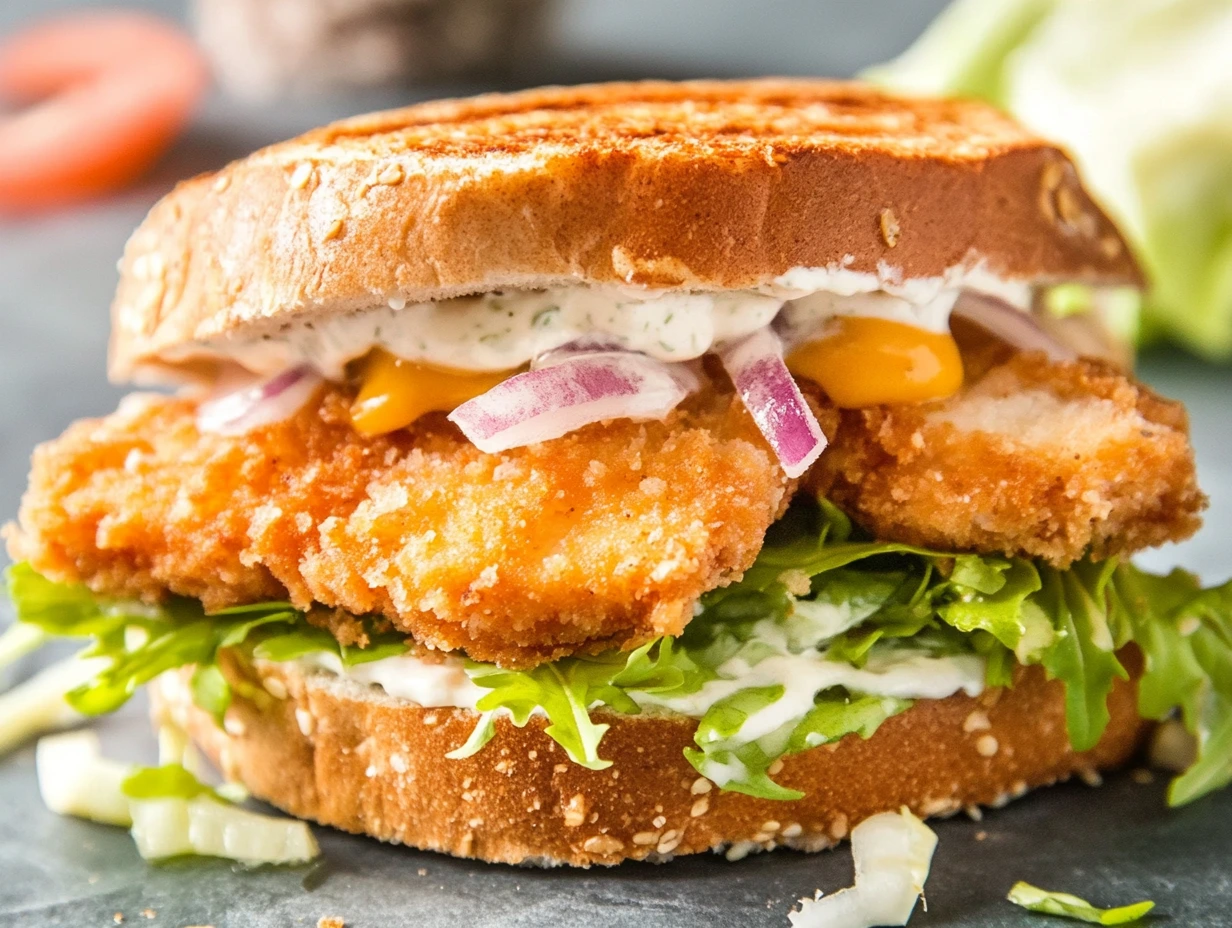A fish sandwich recipe is a must-have for any seafood lover. This guide walks you through creating a crispy, flavorful sandwich with fresh toppings, zesty sauces, and customizable options. Whether you prefer fried, grilled, or baked fish, this recipe will elevate your culinary skills and satisfy your taste buds.

Table of Contents
Why Make a Fish Sandwich at Home?
Making a fish sandwich at home allows you to tailor it to your preferences and dietary needs. You have complete control over the quality of ingredients, ensuring a fresher, healthier, and more delicious result. Plus, homemade fish sandwiches are more economical and provide an opportunity to experiment with flavors and toppings that you won’t typically find in restaurants. It’s a simple yet satisfying way to enjoy a seafood favorite.
Ingredients
Main Ingredients
- Fish Fillets (e.g., cod, tilapia, haddock, or salmon) – 2 pieces
- Bread (e.g., brioche buns, ciabatta rolls, or sandwich bread) – 2 buns
- Flour – ½ cup
- Eggs – 2, beaten
- Breadcrumbs or Panko – 1 cup
- Salt and Pepper – to taste
- Vegetable Oil – for frying (if frying)
- Lettuce Leaves – 2-4 pieces
- Tomato Slices – 4 slices
- Tartar Sauce or Mayonnaise – 2 tablespoons per sandwich
Optional Toppings
- Cheese (e.g., cheddar, American, or Swiss) – 1 slice per sandwich
- Pickles – sliced
- Red Onions – thinly sliced
- Avocado – sliced
- Coleslaw – for added crunch
- Hot Sauce or Sriracha – for a spicy kick
Necessary Equipment
Kitchen Tools You’ll Need
- Cutting Board – for prepping fish and vegetables.
- Sharp Knife – to slice fish fillets and toppings.
- Mixing Bowls – for flour, beaten eggs, and breadcrumbs.
- Tongs or Spatula – to handle fish during frying or grilling.
- Frying Pan or Grill Pan – depending on your preferred cooking method.
- Paper Towels – to pat the fish dry and absorb excess oil.
- Baking Sheet with Wire Rack – for keeping fried fish crispy.
Substitutes for Specific Tools
- If you don’t have a frying pan, an oven-safe skillet or air fryer can be used.
- A food processor can replace a knife to quickly prepare breadcrumbs or slice toppings.
- Chopsticks can work as tongs for handling fish in a pinch.
Step-by-Step Instructions
Preparing the Fish
- Choose Your Fish: Select fresh fish fillets and ensure they’re boneless.
- Pat Dry: Use paper towels to pat the fish dry to help the coating stick.
- Season: Sprinkle both sides with salt and pepper for flavor. You can also add a touch of paprika or garlic powder if desired.
Creating the Coating
- Set Up Coating Station: Prepare three shallow bowls:
- Bowl 1: Flour (seasoned with salt and pepper).
- Bowl 2: Beaten eggs.
- Bowl 3: Breadcrumbs or panko (you can mix in spices like paprika, garlic powder, or dried herbs for extra flavor).
- Coat the Fish:
- Dredge the fish fillet in flour, shaking off excess.
- Dip it into the beaten eggs, ensuring it’s fully coated.
- Press the fish into the breadcrumbs, covering all sides.
- Cook the Fish:
- If frying: Heat vegetable oil in a pan over medium heat. Fry each fillet for 3–4 minutes per side until golden and cooked through.
- If grilling: Lightly oil the grill and cook the fish for about 4–5 minutes per side.
- If baking: Preheat the oven to 400°F (200°C) and bake the fish on a greased baking sheet for 12–15 minutes, flipping halfway through.
Assembling the Sandwich
- Toast the Bread: Lightly toast the buns for added texture and flavor.
- Spread the Sauce: Apply tartar sauce or mayonnaise on the top and bottom buns.
- Layer the Ingredients:
- Start with a lettuce leaf on the bottom bun to create a barrier and prevent sogginess.
- Place the cooked fish fillet on top of the lettuce.
- Add your desired toppings, such as tomato slices, pickles, or cheese.
- Cover with the top bun.
- Serve: Serve immediately with a side of fries, chips, or a simple salad.

Cooking Techniques
Pan-Frying
- Preparation: Heat a frying pan over medium heat and add about ½ inch of vegetable oil. The oil should be hot but not smoking (about 350°F or 175°C).
- Cooking: Place the coated fish fillets in the hot oil. Fry each side for 3–4 minutes until golden brown and fully cooked (internal temperature of 145°F or 63°C).
- Draining: Transfer the fried fillets to a plate lined with paper towels to drain excess oil. This keeps the fish crispy.
Baking
- Preparation: Preheat your oven to 400°F (200°C) and line a baking sheet with parchment paper or lightly grease it.
- Cooking: Arrange the coated fish fillets on the baking sheet and lightly spray them with cooking oil for crispiness. Bake for 12–15 minutes, flipping halfway through, until the coating is golden and the fish is cooked through.
- Serving: Let the baked fish rest for a minute before assembling the sandwich.
Air-Frying
- Preparation: Preheat the air fryer to 375°F (190°C). Lightly spray the air fryer basket with cooking oil.
- Cooking: Place the coated fish fillets in a single layer in the basket. Spray the fillets lightly with cooking oil. Air fry for 10–12 minutes, flipping halfway through, until crispy and cooked through.
- Finishing: Check for doneness, and serve immediately while still crispy.
Crafting the Perfect Bun
Types of Buns
- Brioche Buns: Buttery and slightly sweet, they pair beautifully with the savory fish and toppings.
- Ciabatta Rolls: Rustic and chewy, perfect for holding up to heavier toppings.
- Pretzel Buns: Dense and flavorful, great for adding a unique twist.
- Whole Wheat Buns: A healthier option with a nutty flavor.
- Potato Buns: Soft and fluffy, ideal for a classic fish sandwich experience.
Toasting Tips
- Butter or Oil: Lightly spread butter or brush oil on the cut sides of the bun. This adds flavor and helps achieve a golden crust.
- Stovetop Toasting: Heat a skillet or grill pan over medium heat. Place the buns cut-side down and toast for 1–2 minutes until golden and slightly crisp.
- Oven Toasting: Preheat your oven to 375°F (190°C). Place the buns cut-side up on a baking sheet and bake for 3–5 minutes until toasted.
- Broiling Option: Use the broiler for a quicker toast. Place buns cut-side up under the broiler for 1–2 minutes, watching closely to avoid burning.
Sauce and Condiments
Classic Tartar Sauce
Tartar sauce is the quintessential fish sandwich condiment. Here’s a simple recipe:
- Ingredients:
- ½ cup mayonnaise
- 2 tablespoons finely chopped pickles
- 1 tablespoon capers (optional)
- 1 teaspoon lemon juice
- 1 teaspoon Dijon mustard
- Salt and pepper to taste
- Preparation: Mix all the ingredients in a bowl until well combined. Chill for 15–20 minutes before serving to enhance the flavors.
Creative Alternatives
- Garlic Aioli: A creamy blend of mayonnaise, garlic, and lemon juice for a bold flavor.
- Spicy Sriracha Mayo: Mix mayo with a dash of sriracha for a tangy and spicy kick.
- Honey Mustard Sauce: A sweet and tangy option that pairs beautifully with fish.
- Yogurt-Dill Sauce: Combine Greek yogurt, fresh dill, lemon juice, and a pinch of garlic powder for a lighter, herbaceous alternative.
- Avocado Spread: Mash ripe avocado with lime juice, salt, and a touch of chili flakes for a creamy, healthy option.
Healthier Alternatives
Grilled Fish Sandwich
- Preparation: Marinate fish fillets with olive oil, lemon juice, garlic, and spices like paprika and black pepper.
- Grilling: Heat the grill to medium-high. Cook the fish for 4–5 minutes per side until flaky and charred.
- Assembly: Use whole-grain buns, fresh vegetables, and a light sauce for a nutritious twist.
Low-Carb Options
- Lettuce Wrap Sandwich: Replace the bun with large lettuce leaves. Butter lettuce and iceberg work well.
- Portobello Mushroom “Buns”: Grill large portobello mushroom caps and use them as a substitute for buns.
- Zucchini Boats: Hollow out zucchini halves, grill or bake them, and stuff them with fish and toppings.
- Open-Faced Sandwich: Serve the fish and toppings on a single slice of whole-grain bread or omit the bread altogether for a plated option.

Serving Ideas
Side Dishes That Pair Well
- Crispy French Fries: A classic choice, seasoned with sea salt or spices like paprika.
- Coleslaw: A tangy and crunchy side that complements the richness of the fish.
- Sweet Potato Fries: A healthier and slightly sweet alternative to regular fries.
- Mixed Greens Salad: A fresh, light option with a vinaigrette dressing.
- Grilled Vegetables: Zucchini, bell peppers, and asparagus make excellent accompaniments.
- Corn on the Cob: Grilled or boiled, seasoned with butter and herbs.
Presentation Tips
- Layer Creatively: Arrange the fish and toppings neatly for an appetizing look. A perfectly layered sandwich makes a big visual impact.
- Garnish: Add a sprig of fresh parsley, a wedge of lemon, or a sprinkle of chopped herbs on the plate.
- Serve on a Platter: Use a wooden board or rustic tray for a casual, inviting feel.
- Accompany with Dips: Place sauces like tartar, aioli, or ketchup in small ramekins for dipping.
- Color Contrast: Use colorful side dishes like coleslaw or pickled vegetables to brighten the plate.
Troubleshooting Tips
Common Mistakes
- Fish Sticking to the Pan: This usually happens if the pan or grill isn’t hot enough or if the fish isn’t properly oiled.
- Fix: Ensure the pan is preheated and lightly oil both the fish and the pan or grill. Non-stick pans or parchment paper can help when baking.
- Soggy Coating: This can result from overcrowding the pan or not drying the fish properly before coating.
- Fix: Cook in small batches and pat the fish dry with paper towels before coating.
- Uneven Cooking: If the fillet is too thick, it may cook unevenly.
- Fix: Use thinner cuts of fish or pound thicker fillets to even thickness. Adjust cooking time based on the fillet size.
- Bland Flavor: Forgetting to season the fish or the coating can lead to a lackluster sandwich.
- Fix: Season each layer – the fish, the coating, and the sauce – for a balanced, flavorful bite.
How to Fix Them
- If the fish is overcooked: Add a moist topping like coleslaw or extra sauce to counter dryness.
- If the bread is soggy: Toast the bun or add a lettuce leaf as a moisture barrier.
Variations of Fish Sandwiches
Cajun-Style Fish Sandwich
- Seasoning: Rub the fish with Cajun spices (paprika, cayenne, thyme, garlic powder, and onion powder).
- Cooking: Pan-fry or grill the fish to lock in the bold flavors.
- Toppings: Add pickles, coleslaw, and a spicy remoulade sauce for a Southern twist.
Vegan and Vegetarian Versions
- Vegan “Fish” Sandwich: Use marinated tofu, tempeh, or jackfruit coated with nori flakes and breadcrumbs to mimic fish flavors.
- Vegetarian Option: Swap the fish with grilled or breaded eggplant or zucchini slices.
- Sauces and Toppings: Pair with vegan tartar sauce, lettuce, tomato, and pickles for a satisfying plant-based sandwich.
Storage and Reheating
Proper Storage
- Refrigeration: Store leftover fish fillets in an airtight container in the refrigerator for up to 3 days. Keep buns and toppings separate to avoid sogginess.
- Freezing: For longer storage, freeze cooked fish fillets individually wrapped in plastic wrap and placed in a freezer bag for up to 2 months.
Reheating Techniques
- Oven: Preheat the oven to 375°F (190°C). Place the fish on a wire rack or baking sheet and reheat for 10–12 minutes, flipping halfway through.
- Air Fryer: Heat at 350°F (175°C) for 5–7 minutes to regain crispiness.
- Skillet: Heat over medium heat with a touch of oil for a few minutes per side.
- Microwave: Not recommended for crispy fish as it may become soggy, but it can be used for quick reheating (30–60 seconds).
Nutritional Breakdown
Calorie Count Per Serving
- Fish Sandwich:
- Breaded and fried fish fillet: ~300–400 calories
- Bun: ~150–200 calories
- Toppings and sauce: ~100–150 calories
- Total: ~550–750 calories per sandwich (varies based on preparation and ingredients).
- Healthier Options:
- Grilled fish: Saves ~100 calories compared to fried.
- Lettuce wraps: Eliminates ~150–200 calories from the bun.
Health Benefits of Ingredients
- Fish: High in lean protein and rich in omega-3 fatty acids, which support heart and brain health.
- Vegetables: Provide fiber, vitamins, and antioxidants.
- Whole-Grain Buns: Contain more fiber and nutrients compared to white bread.
- Homemade Sauces: Allow you to control sugar, fat, and sodium content.
FAQs
What fish is best for sandwiches?
The best fish for sandwiches are mild, flaky varieties that hold their shape during cooking. Popular options include:
- Cod: Mild flavor, tender texture.
- Haddock: Similar to cod, slightly sweeter.
- Tilapia: Affordable and easy to cook.
- Salmon: Rich and flavorful, for a unique twist.
- Halibut: Firm and meaty, perfect for grilling.
Can I use frozen fish?
Yes, frozen fish works well as long as it is properly thawed:
- Thawing: Place frozen fish in the refrigerator overnight or use the defrost function on your microwave.
- Pat Dry: Remove excess moisture with paper towels before seasoning or coating.
How can I make it gluten-free?
To make a gluten-free fish sandwich:
- Breadcrumbs: Use gluten-free breadcrumbs or crushed rice crackers.
- Flour: Substitute with almond flour, rice flour, or a gluten-free flour blend.
- Buns: Opt for gluten-free buns, lettuce wraps, or portobello mushrooms as a substitute.
Are fish sandwiches healthy?
Fish sandwiches can be healthy depending on how they’re prepared:
- Grilled or baked fish: Lower in calories and fat compared to fried options.
- Whole-grain buns: Add fiber and nutrients.
- Toppings: Fresh vegetables and light sauces keep the sandwich nutritious.
By customizing ingredients, you can create a balanced meal.
What sides go best with fish sandwiches?
Fish sandwiches pair well with a variety of sides, such as:
- French fries or sweet potato fries
- Coleslaw
- Mixed greens salad
- Potato chips
- Grilled vegetables
- Pickled vegetables
How do I prevent sogginess?
To avoid a soggy sandwich:
- Toast the buns: This adds a barrier against moisture.
- Lettuce barrier: Place a lettuce leaf between the bun and the fish to keep the bread dry.
- Drain the fish: After cooking, let the fish rest on paper towels to remove excess oil or moisture.
- Assemble just before serving: Don’t add wet toppings or sauces until you’re ready to eat.
To enrich the Fish Sandwich Recipe article with internal links and provide readers with additional relevant content, consider the following opportunities:
- Pair the sandwich with crunchy sides like Fried Zucchini Recipe for a complete meal experience.
- For seasoning inspiration, recommend readers explore the Fish Taco Seasoning Recipe, which could add a bold flavor to the fish fillet.
Conclusion
A fish sandwich is a versatile and delicious dish that can be easily customized to suit any palate. By following this guide, you’ll have the tools to create the perfect sandwich, whether you prefer a classic fried fillet, a healthier grilled option, or a creative twist with unique toppings and sauces. From choosing the right fish and cooking technique to crafting the perfect bun and pairing it with complementary sides, every detail contributes to a satisfying meal. Don’t forget to experiment with flavors and draw inspiration from related recipes like fish tacos or fish cakes to expand your culinary repertoire.
Whether you’re making a quick lunch, a family dinner, or a gourmet treat, a well-made fish sandwich is always a winner. So, get creative in the kitchen, and enjoy the process of crafting your perfect sandwich!

